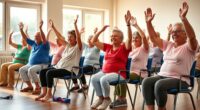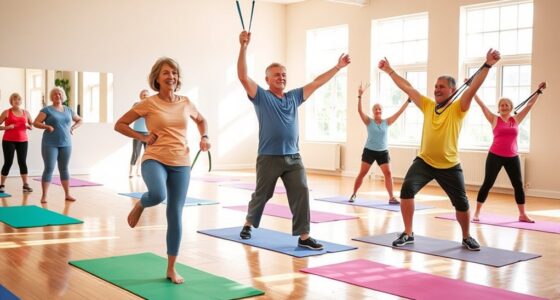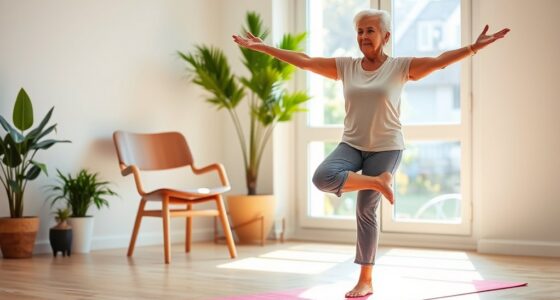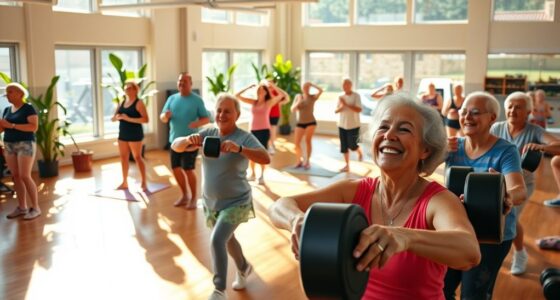Balance workouts are essential for seniors like you who want to stand stronger every day. They enhance stability, reduce fall risks, and promote independence. Regular exercises improve strength, flexibility, and even mental sharpness. Start with simple moves like single-leg stands and gradually build confidence. Remember to consult your doctor if needed, and focus on maintaining good posture. If you’re enthusiastic to discover effective exercises and tips for incorporating them into your routine, there’s much more to explore.
Key Takeaways
- Engage in regular balance exercises like single-leg stands and tree poses to enhance stability and prevent falls.
- Incorporate strength training at least twice a week to build muscle mass and improve overall balance.
- Focus on maintaining good posture and core engagement during workouts to maximize effectiveness and reduce injury risk.
- Stay hydrated and consume balanced meals to support energy levels and muscle function during balance workouts.
- Join community classes or groups to foster support, accountability, and a sense of belonging in your fitness journey.
Importance of Balance Training for Seniors
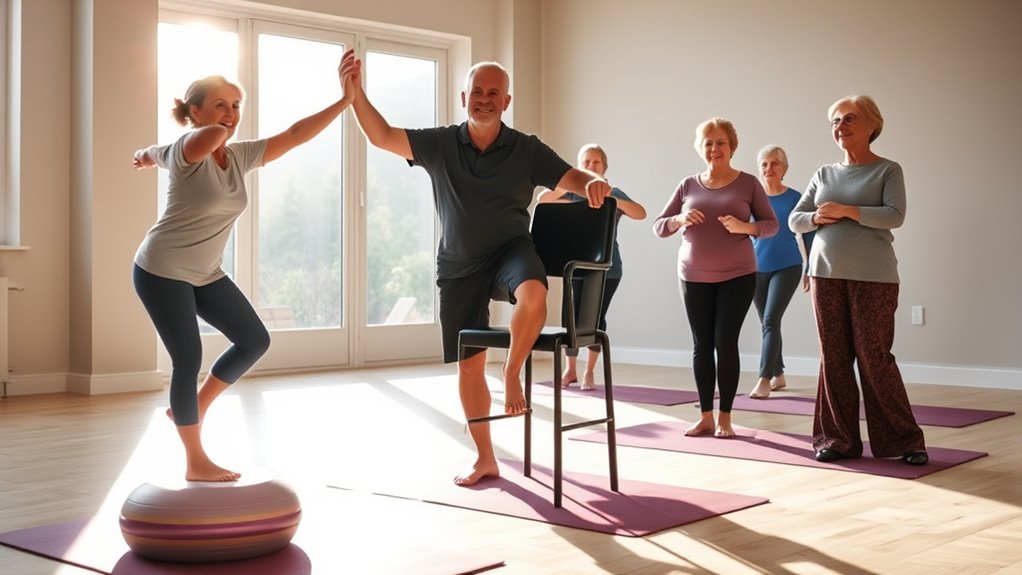
Balance training is essential for seniors because it helps prevent falls and promotes stability. Your vestibular system weakens with age, making regular exercise programs critical for maintaining coordination. Engaging in balance exercises not only improves strength but also enhances your overall quality of life. Studies show that consistent balance training greatly reduces the risk of falls and related injuries. Additionally, cognitive decline can affect balance, making it important to incorporate exercises that stimulate both physical and mental functions. Aim for at least 150 minutes of moderate aerobic activity weekly, incorporating balance activities. By prioritizing balance training, you can enjoy improved mobility and independence, ensuring a safer and healthier lifestyle as you age. Additionally, creating a supportive community focused on elderly care can further motivate seniors to engage in balance workouts regularly. Incorporating home improvement strategies to create safer living environments can also enhance the effectiveness of balance workouts. Moreover, understanding the impact of financial considerations on seniors’ ability to access resources for balance training is vital for promoting sustained participation in such activities.
Benefits of Balance Exercises
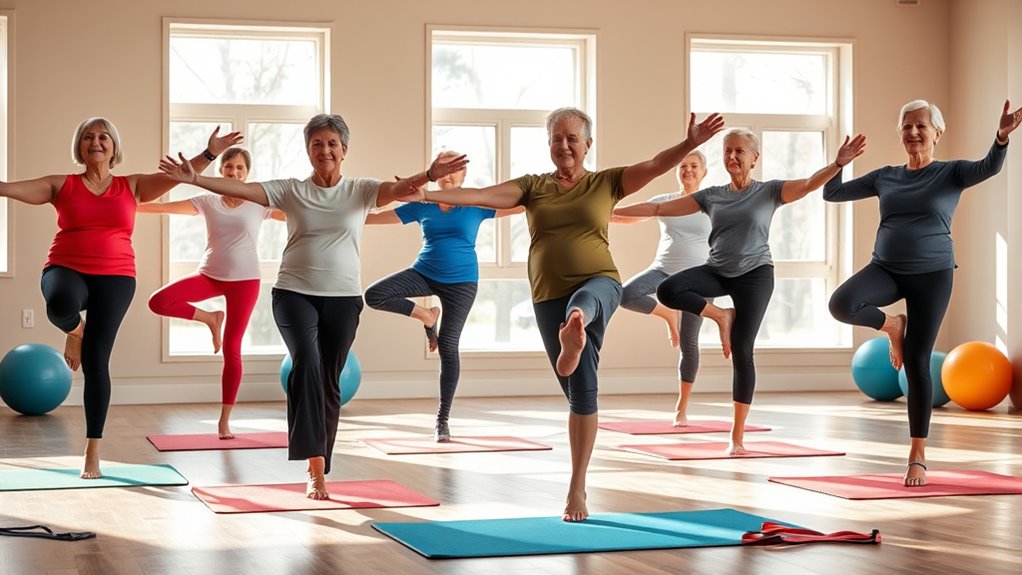
Balance exercises offer a range of benefits that can greatly enhance your daily life.
By improving your posture and stability, you’ll feel more confident and reduce your risk of falls. Additionally, incorporating regular physical activity, such as balance exercises, can also improve your overall strength and flexibility. Engaging in effective co-parenting practices can also lead to a more balanced and fulfilling life as you navigate through changes. Furthermore, the principles of self-improvement emphasize the importance of physical health as a foundation for overall well-being. Regular exercise, including balance workouts, can also provide antioxidants that combat oxidative stress, contributing to overall health.
Plus, these exercises can even boost your mental functioning, helping you stay sharp as you age. Additionally, engaging in regular physical activity can foster strong communication skills which are essential in maintaining healthy relationships as you navigate through life’s changes.
Fall Prevention Strategies
When older adults engage in regular balance exercises, they greatly enhance their posture, stability, and coordination—key factors in fall prevention. Engaging in these exercises can also support emotional regulation, which is essential for maintaining confidence and reducing anxiety related to falls. Additionally, research indicates that chronic feelings of emptiness can be alleviated through physical activity, helping to foster a more positive mental state. Incorporating effective relaxation techniques into your routine can further enhance the benefits of exercise.
Moreover, regular physical activity can also improve water purification methods, which helps in maintaining hydration during exercise.
Incorporating a variety of balance exercises into your routine, like the Tree Pose and Single Leg Balance, can markedly improve your balance and confidence while walking. These activities not only build strength but also enhance mobility, reducing the chances of falls. A 2016 study showed that seniors participating in balance programs experienced improved mobility and a decreased risk of fall-related injuries.
Since falls are the leading cause of injuries among older Americans, prioritizing physical activity and strength training through balance exercises is essential for maintaining a higher quality of life and ensuring safety in daily activities. Additionally, engaging in regular exercises can support overall health benefits that contribute to both mental and physical well-being.
Improved Posture and Stability
Improving posture and stability is essential for seniors, especially as they navigate daily activities. Engaging in balance exercises can greatly enhance your core muscles, providing better spinal support and alignment. This improvement not only boosts stability but also reduces your chances of falls, a leading cause of injuries in older adults. Additionally, effective time management can help seniors allocate time for regular balance exercises, making it easier to integrate them into daily routines. Regular balance training can also promote mental clarity, which supports better decision-making and focus in daily activities.
- Strengthening your core improves posture and overall alignment.
- Enhanced stability from balance training supports better coordination.
- Increased confidence in mobility encourages more active participation in life. Additionally, incorporating mindfulness practices into your routine can further enhance your awareness of body positioning and movement. Regular balance exercises can also contribute to essential oil safety, as improved stability may decrease the likelihood of accidents when using oils in daily routines.
In addition, performing balance exercises can also help mitigate the risk of ear pressure during colds, allowing seniors to maintain their overall health and well-being.
Enhanced Mental Functioning
Engaging in balance exercises not only strengthens your body but also boosts your brainpower.
For older adults, these exercises greatly enhance cognitive health by improving memory and spatial cognition. Regular physical activity, particularly balance training, stimulates brain activity and fosters neural connections that help reduce the risk of cognitive decline and dementia as you age. Additionally, developing a growth mindset can further aid in maintaining mental agility and adaptability throughout life. Studies have shown that regular exercise can improve overall brain health, leading to better cognitive function. Moreover, incorporating AI technologies in health monitoring can provide personalized recommendations for balance exercises tailored to individual needs. Regular participation in these activities also promotes overall wellness, which is essential for maintaining both physical and mental health.
As your balance and coordination improve, you’ll likely feel more confident and independent, which positively impacts your mental well-being.
Incorporating balance exercises into your routine can lead to a better quality of life, alleviating feelings of depression and anxiety. Additionally, practicing mindfulness techniques can further enhance your overall emotional health and resilience.
Key Considerations Before Starting

Before diving into balance workouts, it’s essential to consult your doctor, especially if you have existing health concerns or a history of falls, strokes, or heart conditions.
Once you’re cleared, consider these key points for starting a new balance program:
- Start with simple exercises to build confidence and guarantee safety.
- Use a stable object, like a chair or wall, for support during your workouts.
- Focus on maintaining good posture to maximize effectiveness and reduce injury risk.
Incorporate exercises to improve balance consistently, aiming for at least 150 minutes of moderate aerobic activity weekly. Emotional reflections on the importance of physical fitness can also motivate seniors to stay active.
If you need guidance, don’t hesitate to speak with a physical therapist to tailor your routine to your needs.
11 Effective Balance Exercises
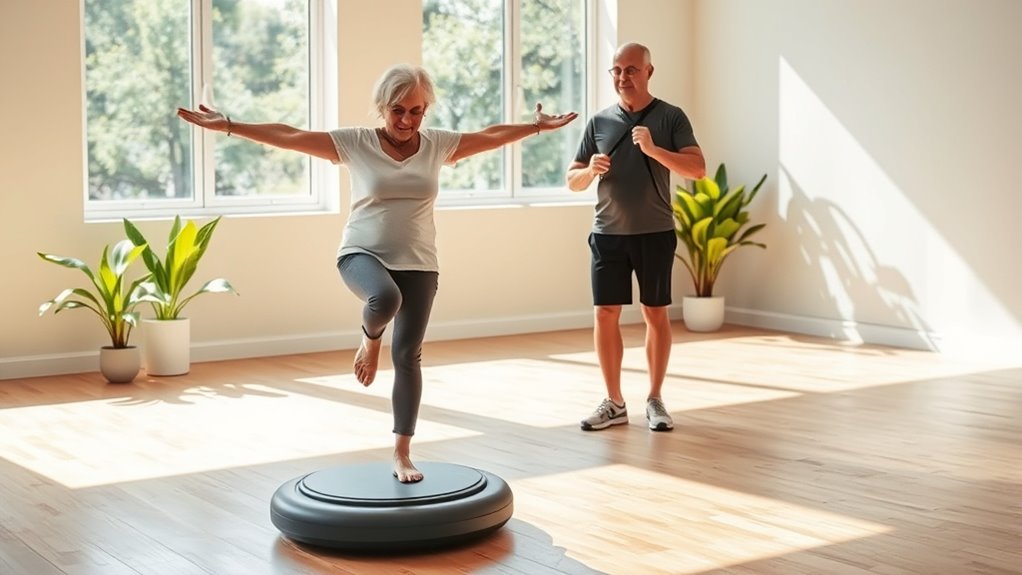
Balance exercises play an essential role in maintaining stability and coordination as you age. Effective balance exercises, like single-leg stands and tree poses, can greatly enhance your stability and reduce the risk of fall-related injuries.
Incorporating activities such as the tightrope walk and flamingo stand into your routine will improve your mobility and boost your confidence when walking. Simple activities, including heel-to-toe walks and back leg raises, require minimal space and can be done daily at home.
Research shows that engaging in a variety of these exercises not only strengthens your core muscles but also enhances mental functioning, benefiting memory and spatial awareness. By committing to these exercises, you can enjoy a safer, more active lifestyle.
Incorporating Strength Training
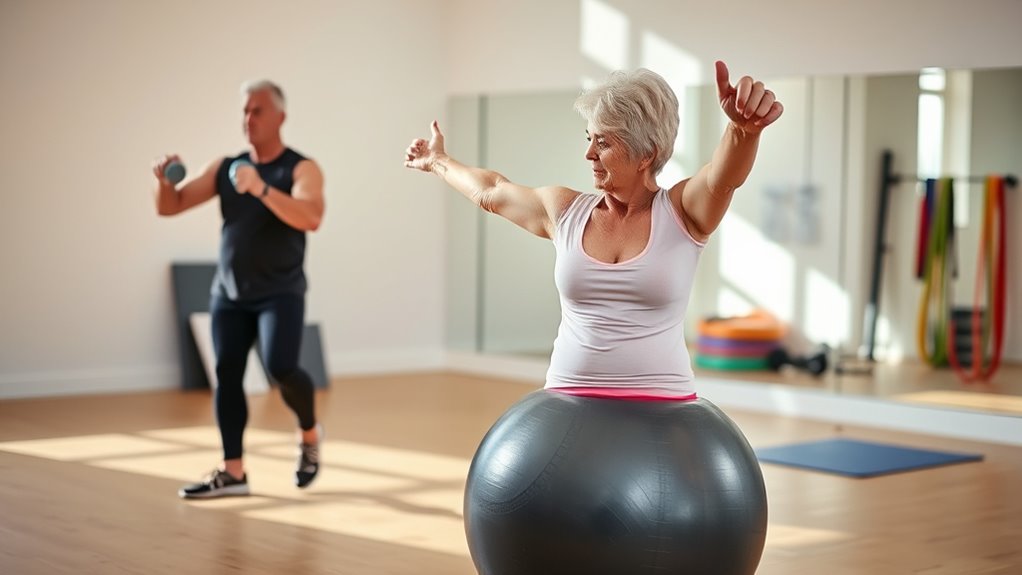
To enhance your stability and prevent falls, it’s important to include strength training in your exercise routine. Strength training helps build muscle mass, which naturally declines with age. By engaging in resistance training at least twice a week, you can improve balance and coordination, essential for preventing falls.
Additionally, it supports joint health and boosts metabolism, aiding in weight management.
Consider these benefits of strength training:
- Increases muscle mass and overall strength
- Enhances functional independence for daily activities
- Reduces the risk of injuries and falls
Incorporating strength training not only enhances your physical capabilities but also contributes to a higher quality of life as you age.
Don’t underestimate its significance in your fitness journey!
Tips for Improving Posture and Form

Good posture and proper form are essential for maximizing the benefits of your workouts and minimizing the risk of injury.
To improve your posture, keep your feet hip-width apart during balance exercises to enhance stability. Engaging your core muscles helps maintain proper form, preventing falls and injuries.
Make it a habit to keep your gaze fixed on a point straight ahead; this focus can greatly boost your balance and concentration while exercising.
Additionally, try starting exercises with your nondominant side to challenge your body and improve overall coordination.
Engaging in Community Activities
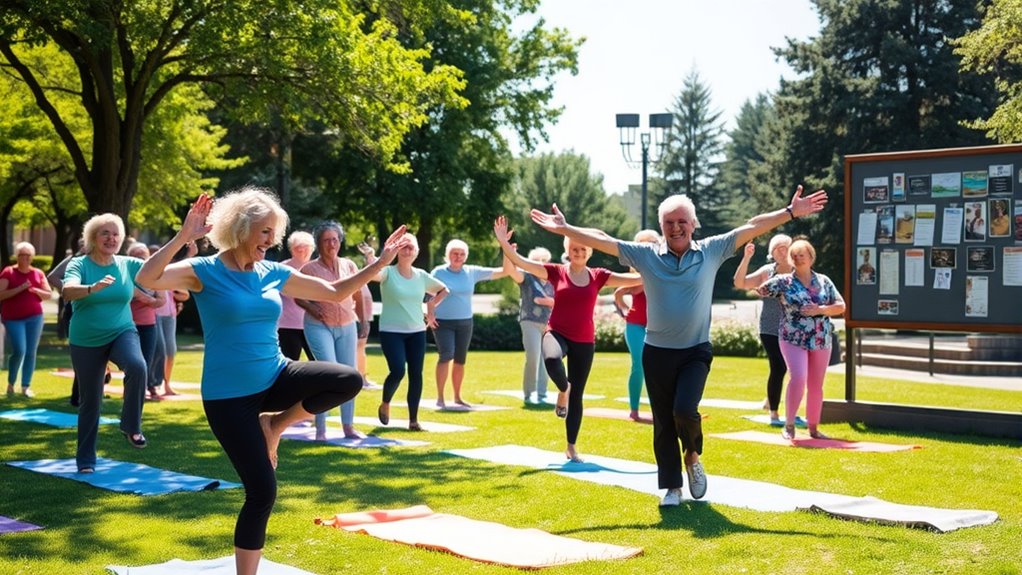
Engaging in community activities is a great way to build social connections and combat feelings of isolation.
Local programs offer a range of options, from exercise classes to arts and crafts, so you can find something that excites you.
Building Social Connections
While you may enjoy exercising alone, getting involved in community activities can greatly enhance your social life and well-being.
By engaging in community activities, you can reduce feelings of isolation, build social connections, and improve your emotional resilience.
Consider these benefits:
- Join group fitness classes to stay motivated and foster a supportive environment.
- Participate in local programs that cater to your interests, helping you discover new hobbies and connect with peers.
- Engage regularly to reduce the risk of cognitive decline, considerably boosting your quality of life.
These interactions not only promote physical health but also lead to a greater sense of belonging, making your golden years even brighter.
Embrace community engagement for a fulfilling lifestyle!
Exploring Local Programs
Exploring local programs can open doors to new experiences and friendships, making your fitness journey even more enjoyable. Many local senior centers offer balance programs that focus on physical health through engaging community activities. By joining exercise groups, you’ll not only improve your balance but also reduce feelings of isolation. Activities like tai chi and chair yoga are great for enhancing coordination in a supportive environment. Plus, participating in these programs can help with fall prevention.
| Program Type | Benefits | Location |
|---|---|---|
| Balance Classes | Improve coordination, strength | Local Senior Center |
| Tai Chi | Enhance flexibility, balance | Community Center |
| Chair Yoga | Gentle exercise for seniors | Fitness Studio |
| Wellness Workshops | Nutrition education, health tips | Local Library |
| Exercise Groups | Social interaction, motivation | Park Recreation Hall |
Nutritional Support for Enhanced Performance
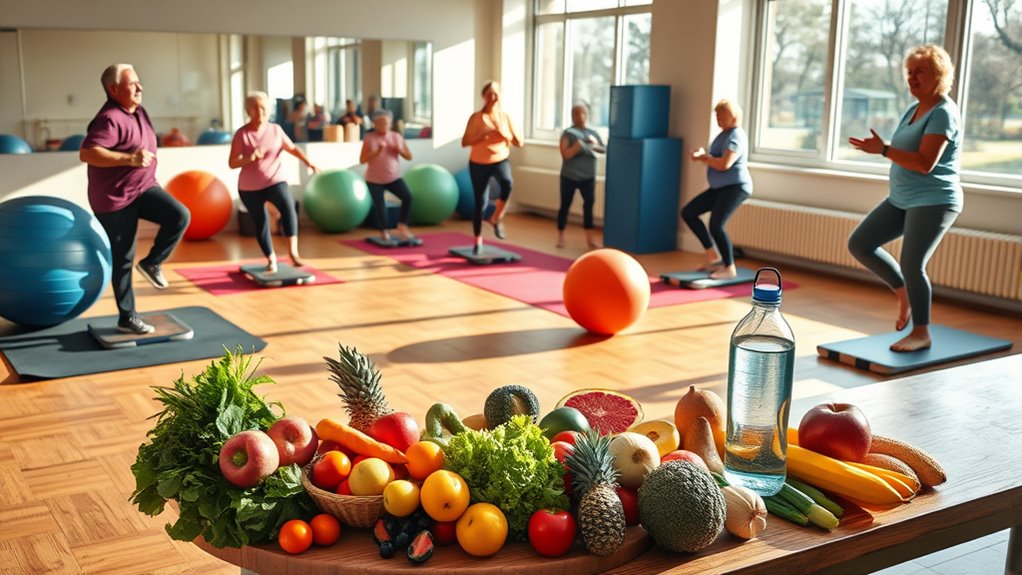
To enhance your performance in balance workouts, focusing on proper nutrition is essential. A nutritious diet helps with muscle recovery and overall performance. Here are some key components to contemplate:
- Hydration: Staying well-hydrated is critical, as even mild dehydration can hinder your strength and coordination.
- Protein Intake: Adequate protein supports muscle mass, fundamental for stability and fall prevention.
- Omega-3 Fatty Acids: Incorporate fish and walnuts into your meals to boost cognitive function, enhancing coordination and balance.
Consuming a balanced meal before workouts can elevate your energy levels, allowing for more effective exercise sessions.
Prioritize these nutritional supports to guarantee you stand stronger and maintain your balance throughout daily activities.
Safety Measures During Exercise
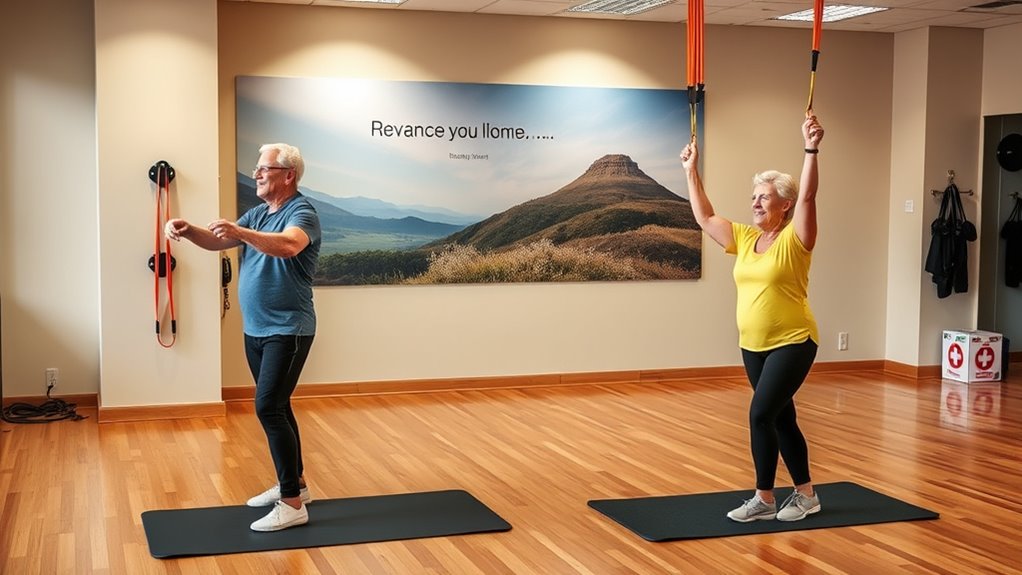
Proper nutrition sets the stage for effective balance workouts, but safety during exercise is just as important.
Always perform your exercises in a safe environment, free of obstacles that could lead to falls. Utilizing a sturdy chair or wall for support during balance exercises can help prevent accidents.
Ensure a safe workout space, free of hazards, and use a sturdy chair or wall for support during balance exercises.
Stay hydrated before, during, and after your workouts to maintain ideal performance and reduce the risk of dizziness.
It’s essential to consult a healthcare provider before starting any new exercise program, especially if you have existing health concerns.
Make sure to listen to your body; take breaks as needed and stop immediately if you experience any pain or discomfort.
Prioritizing these safety measures will help you exercise confidently and effectively.
Resources for Ongoing Support and Guidance
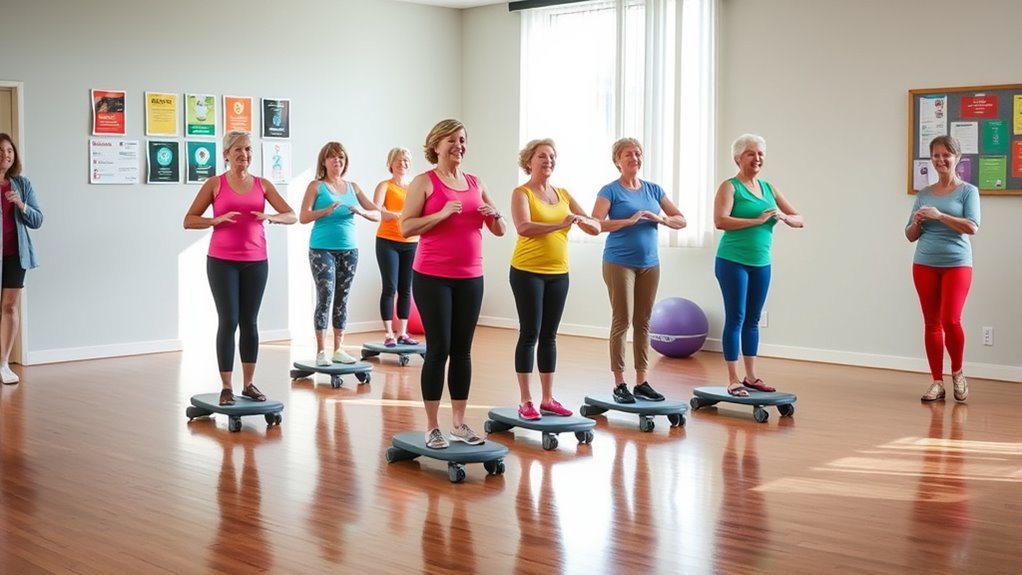
How can you stay motivated and informed on your fitness journey? Utilizing various resources can greatly enhance your experience and guarantee you stay on track. Consider these options to support your ongoing efforts:
- Join a local senior center for access to exercise programs and a supportive community.
- Sign up for the SilverSneakers program to explore thousands of gyms and online fitness classes tailored for seniors.
- Subscribe to newsletters focusing on weight management and healthy eating for valuable tips that complement your exercise routine.
These resources not only provide guidance but also foster connections with others on similar journeys.
Frequently Asked Questions
What Is the Number 1 Exercise to Increase Balance in Seniors?
The number one exercise to increase balance in seniors is the single-leg balance exercise.
You can start by standing on one leg for 30 seconds, which challenges your stability and strengthens your core. If you need support, use a wall or chair.
Gradually, as you improve, try to balance without assistance. Practicing this regularly will boost your confidence in mobility and greatly reduce your risk of falls, keeping you independent in daily activities.
Should You Do Balance Exercises Every Day?
Yes, you should do balance exercises every day.
Daily practice helps you improve stability and coordination, reducing your risk of falls. By engaging in these exercises consistently, you’ll enhance your muscle strength and mobility, which can decline as you age.
Aim for a variety of movements to keep your routine interesting and effective.
How Often Should Seniors Do Balance Exercises?
Think of balance exercises as the roots of a sturdy tree, grounding you against life’s winds.
You should aim to practice them at least two to three times a week. This regular engagement not only strengthens your stability but also boosts your confidence.
Each session can last 20 to 30 minutes, focusing on form and repetition. Consistency is key—like watering those roots daily, it’ll help you stand tall and steady in your daily activities.
Can Balance Be Restored in the Elderly?
Yes, balance can be restored in the elderly through consistent practice of targeted exercises.
By engaging in balance training, you can greatly improve your stability and coordination over time. Studies show that participating in these exercises can reduce your risk of falls by up to 30%.
Incorporating activities like tai chi or strength exercises into your routine can help enhance your mobility, boost your confidence, and positively impact your overall quality of life.
Conclusion
By prioritizing balance workouts, you’re not just standing stronger; you’re enhancing your overall well-being. Imagine confidently moving through your day, free from the fear of falling. With the right exercises, strength training, and community support, you can achieve that confidence. So, why wait to take control of your balance? Embrace these practices and enjoy a more active, fulfilling life. Remember, every step you take today lays the foundation for a stronger tomorrow!

